Godzilla Interruption: All Monsters Attack… Because Nobody Talks about It Much
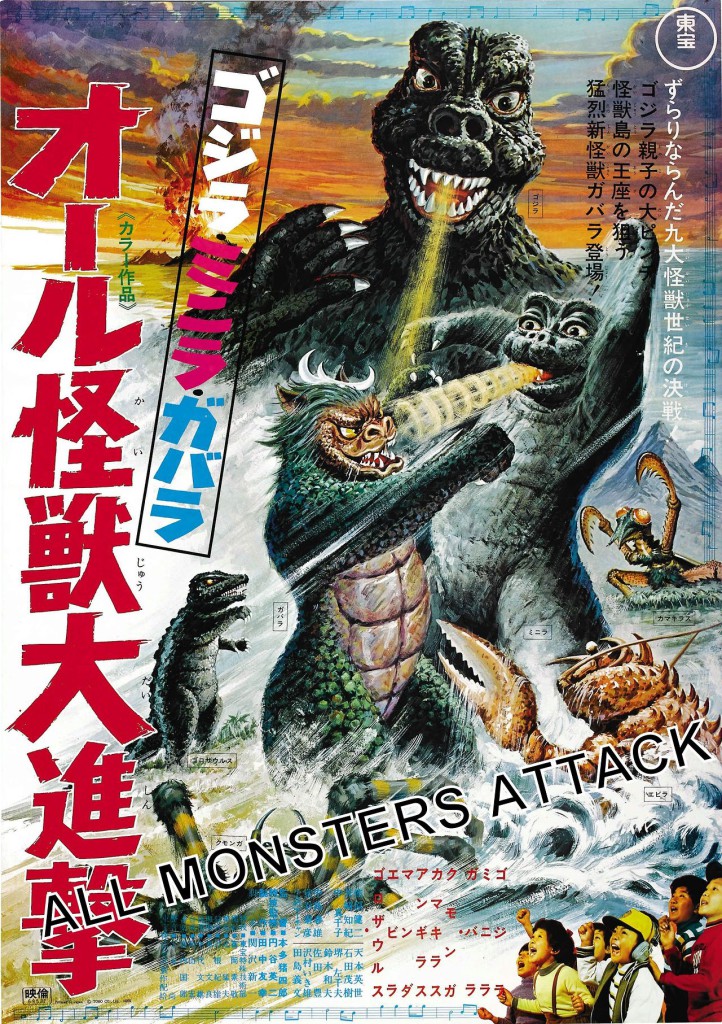 I now interrupt my continuing “History of Godzilla on Film” to bring you an Up Close and Personal look at one particular movie: 1969’s All Monsters Attack, also known as Godzilla’s Revenge.
I now interrupt my continuing “History of Godzilla on Film” to bring you an Up Close and Personal look at one particular movie: 1969’s All Monsters Attack, also known as Godzilla’s Revenge.
It seems like an out-of-left field pick, since this movie has a poor reputation among the kaiju fans. As film historian Richard Pusateri says on the audio commentary for the current DVD: “Fans cannot decide if this is the worst movie of the series, or the second worst.”
However, I picked this movie for spotlight attention because it rarely receives any attention. Most Godzilla fans have seen it all the way through only once — probably in the English-dubbed version — and then left it on the shelf. With its chunks of stock footage lifted from earlier Godzilla films, fantasy elements that relegate the monsters to existence only in the imagination, and a target audience of third- and fourth-grade children, All Monsters Attack is easy for adult viewers to dismiss.
However, the movie contains elements unique among the classic Godzilla series that make it worthy of discussion. And for good or bad, it does have SF legend Ishiro Honda in the director’s chair in his penultimate Godzilla movie.
So let us go pay a visit to late-1960s industrialized Japan and meet a bullied latchkey kid with dreams of monsters.
The Background of All Monsters Attack
Toho Studios planned to conclude the Godzilla series with 1968’s epic Destroy All Monsters. But their resolution did not hold for long. Although the studio system would not collapse for another year, Toho’s movies were doing less business because of television’s popularity. When the studio heads decided to make another Godzilla movie, it was because they devised a way to make it as inexpensively as possible.
Rival studio Daiei’s 1968 movie Gamera vs. Viras inspired Toho’s choice. The Gamera film (released in the U.S. as Destroy All Planets) used battle footage from two previous Gamera movies to expand the running time and reduce the budget, and it used child heroes for direct appeal to the kiddie crowd. Toho gave instructions to producer Tomoyuki Tanaka to create a Godzilla film for children that made extensive use of existing special effects footage.
Screenwriter Shinichi Sekizawa, who wrote the majority of the Godzilla films, worked with director Ishiro Honda to put together a movie script that could re-use large sections of Ebirah, Horror of the Deep and Son of Godzilla. With special effects director Eiji Tsubaraya too sick to take on the work, Ishiro Honda handled the visual effects with the aid of Tsubaraya’s protégé Teruyoshi Nakano.
Two months after All Monsters Attack premiered in Japan in December 1969, Eiji Tsubaraya was dead and Toho shut down its Special Effects Department. And so the final Godzilla film of the ‘60s was the harbinger of the low-budget days ahead.
The Secret Life of Ichiro Mitty: The Story of All Monsters Attack
All Monsters Attack takes place in the “real world.” Although considered part of the Godzilla series, there is no in-story indication that the monsters exist beyond movies, toys, and the imagination of its child hero, Ichiro (Tomonori Yazaki). No one outright denies the monsters’ reality, but the film’s naturalistic style away from the VFX scenes and the attitude of the adults indicate that this is “our” world… and it’s a dreary place.
The story takes place in the industrialized city of Kawasaki, located between Tokyo and Yokohama. Ichiro is a latchkey kid whose father (Kenji Sahara) works for the railroad and whose mother (Machiko Naka) has a job in the hospitality industry. When not spending time alone, dreaming of the creatures on Monster Island and trying to invent a radio to speak to them, Ichiro hangs out with a friendly neighbor, toymaker Mr. Shinpei (Eisei Amamoto). Ichiro deals with bullying almost daily from a gang of kids led by one nicknamed “Gabara.”
During a day when neither Ichiro’s mother or father can come home for the evening, Ichiro fantasizes about flying to Monster Island where he meets Godzilla’s son, Minira (Marchan the Dwarf, a novelty pro wrestler). The two spend time watching Minira’s irritable father Godzilla (Hauro Nakajima) fight battles from previous movies.
Ichiro’s unsupervised wanderings through the industrial shells and urban prairies of Kawasaki bring him to the attention of two bank robbers (Sachio Sakai and Kazuo Suzuki) hiding in an abandoned building. The two kidnap the boy and plan to use him as a hostage. But Ichiro uses his ability to place himself into a trance to ask Minira for help. He watches as Minira learns to stand up for himself against the bully monster Gabara (Yasuhiko Kakuyuki). Godzilla eventually pounds Gabara in the only major new fight footage.
Ichiro wakes up from the empowerment dream, turns into Kevin McCallister from Home Alone, and outwits the two robbers until Mr. Shinpei and the police arrive. Although his latchkey kid existence continues, Ichiro now swells with confidence, and immediately goes to beat up the kid Gabara and commit a petty prank on a poor sign painter. Victory!
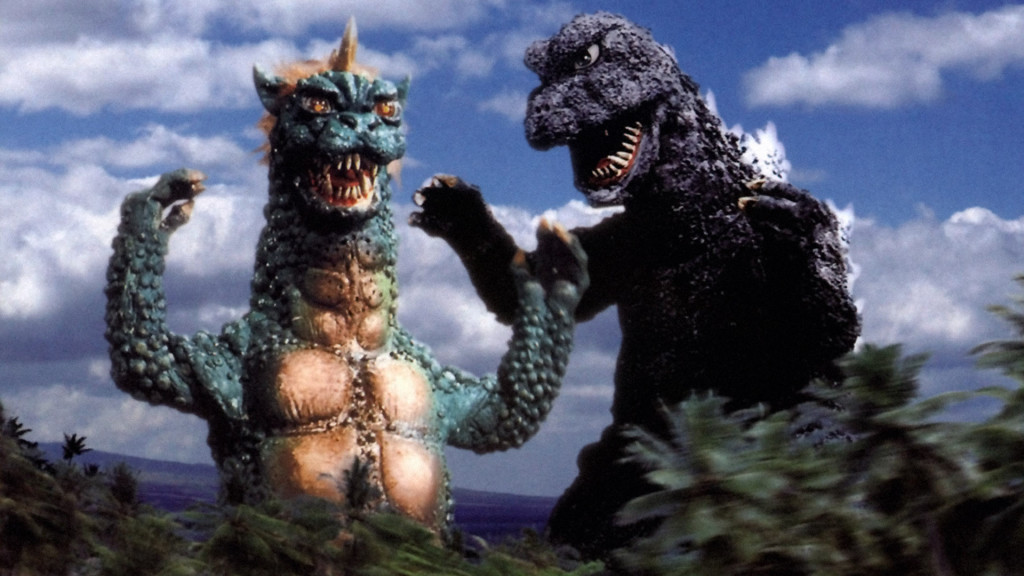 The Monster World
The Monster World
Ichiro has three different dream voyages to Monster Island, in each one interacting with Godzilla’s “son” Minira (often written as “Minilla,” and called “Minya” in the English dub). In Ichiro’s fantasy world, Minira can shrink down to child size and speak (voice of Midori Uchiyama), but grows back to giant size when necessary to interact with Godzilla or Gabara.
Ishiro Honda also directed the effects sequences, the only time he took on this duty. It was probably a cost-cutting maneuver: instead of having principle photography and the VFX unit shoot simultaneously on different stages, All Monsters Attack shot on a quick one-month schedule with principle photography first, and then VFX done afterwards on the same small stage. However, because the effects scenes included the lead actor — another anomaly — there was artistic justification for Honda to direct these scenes as well. Young actor Tomonori Yazaki performs well across from Minira, likely benefiting from having Honda direct him in both the real world and the monster world.
In Ichiro’s first visit to Monster Island, he gets an overview of various other famous monsters — none of whom reappear in the movie — through footage from Destroy All Monsters and King Kong Escapes. The new footage of Ichiro in the jungle matches well with the stock shots, but once he and Minira settle down to watch complete scenes from other movies, the excitement ebbs. Viewers see an edited version of Godzilla’s two fights with Ebirah from Eibrah, Horror of the Deep and the fight with the Kamacuras from Son of Godzilla. Taken out of original context and scored with lighter music, these otherwise fun effects scenes lose their impact. It’s more enjoyable to watch Ichiro talking with Minira; the dialogue is simplistic, but effectively relates a child’s everyday problems and stresses to a young monster who is terrified of a bully and bit afraid of his “dad.” (Godzilla does not cut a strong parental figure for much of the movie, and at one point knees poor Minira in the gut.)
Ichiro’s second visit has a brief bout between Minira and the sole new monster, Gabara, along with Godzilla’s fight with Kumonga from Son of Godzilla and stand against the fighter planes from Ebirah, Horror of the Deep. Gabara is an odd monster more suited to play an ogre in a fairy tale than an opponent in a Godzilla movie. But the lumpy beast with the electro-shock hands ably fills the function of an obnoxious bully. Just from his brief taunting and tormenting of Minira, Gabara makes audiences really loathe him.
The third visit is the first of All Monsters Attack’s trio of climactic confrontations. Ichiro goes into a trance to see Minira finally stand up to Gabara, and the boy helps out his monster pal with a bit of Road Runner cartoon strategy to knock Gabara off a seesaw-rock. Godzilla steps in after Minira has learned his lesson in self-reliance, and the Big-G wipes up the island with Gabara, who never stood a chance of going even half a round with the King of the Monsters.
This monster showdown will never appear on anyone’s list of classic kaiju fights. But it isn’t half bad, and the rich foliage and greenery of Monster Island look far better than the empty field of Godzilla vs. Megalon. Children are sure to enjoy it as well, since the victory over a punk like Gabara feels earned for Minira, even if Godzilla could have roasted the twerp in seconds. Godzilla never has to play the clown or hang out with a kid, since all that responsibility rests with Minira, so our favorite giant monster comes out of all this unsullied. Which already puts All Monsters Attack far, far ahead of the 1998 U.S. Godzilla.
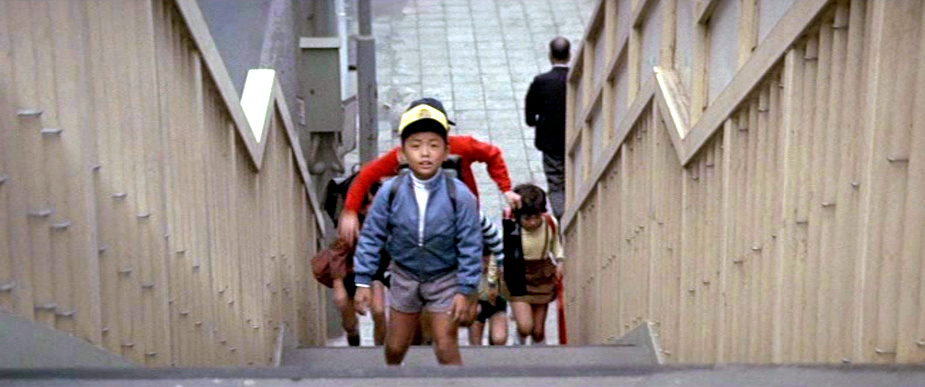 The Human World
The Human World
Viewers may not come to All Monsters Attack to watch the problems of working class Japanese families in a polluted city, but the heart of the movie lies here, as do the sympathies and interests of Ishiro Honda. These scenes resemble nothing else in the Godzilla canon, emphasizing a naturalism removed from the government conference rooms, newspaper offices, and gee-wiz laboratories that dominate kaiju films. Bright colors and shiny surfaces are replaced with drab gray blocks and ugly smoke stacks puncturing a corroded sky. In places, the abandoned buildings and rubble-strewn yards resemble the design of Michael Radford’s film version of Nineteen Eighty-Four. Not what you expect from either Godzilla or a children’s movie.
The human story splits between a child coping with loneliness and finding personal strength, and a more mature look at the change in the traditional Japanese family. The screenplay wants adult viewers to take away a lesson about placing themselves more in their children’s life, although it offers no solution for how to do that if both parents must work jobs in order to support the family. All the screenplay can do is acknowledge the problem exists.
What’s most intriguing about the human drama in All Monsters Attack is the glimpse it gives into a part of the career of Ishiro Honda that few Westerners know about. After the success of his SF films in the early ‘60s, Honda found himself assigned almost exclusively to special effects and monster pictures. Honda had a broad career before this, first as an assistant to his close friend Akira Kurosawa, and then directing many different genres, such as romances (Love Makeup and A Rainbow Plays in My Heart), war epics (Eagle of the Pacific), comedies (Seniors, Juniors, Co-Workers), and crime dramas (The Scarlet Man). Few of these have seen release in English-speaking countries, leaving a large area of Honda’s output unexplored outside Japan.
According to many who were close to the director, his goal was to make films similar to those of Yasujiro Ozu, one of the most acclaimed of all Japanese filmmakers. Ozu specialized in restrained dramas about contemporary life, of which his most famous is the marvelous Tokyo Story. Some of the influence of Ozu appears in scenes in Godzilla, such as the tense dinner at Dr. Yamane’s house. However, Honda’s SF films usually focused on his interest in humanity coming together to fight off a global menace, a reflection of his cautiously optimistic views. Although these epics gave Honda the chance to explore large human emotions, they rarely gave him the opportunity to explore intimate drama.
All Monsters Attack allowed Honda a chance to indulge his Ozu-side within a Godzilla film. The opening shots of smoke stacks and thick traffic moving along roads and bridges reflect the way Ozu opened and made transitions in many of his movies. There are also small moments of subtle characterization sprinkled throughout that don’t strike viewers until watching the movie a second time. When Ichiro expresses his new independence to his mother at the conclusion, she gently wipes a tear from her face as the boy leaves, indicating that she knows nothing will really change for her.
A statement Honda made near the end of his life adds an extra layer of autobiography to Ichiro’s story:
My nightmares are almost always about war — wandering the streets, searching for something that’s lost forever. But it’s possible for me to will myself to have pleasant dreams. For me, the most wonderful fragrance in the world is new film. You open the canister for the first time and breathe deeply. That night, the same wonderful fragrance fills your dreams. It’s grand.
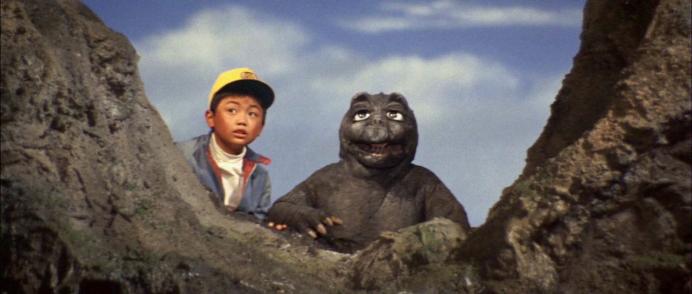 A pleasure for fans of Toho’s fantasy films is the number of familiar faces in the cast, most of whom show up for only a scene or two but bring that special quality missing from the post-studio system films of the ‘70s. Kenji Sahara, Yoshifumi Tajima, Ikio Sawamura, Sachio Sakai, and Eisei Amamoto all add life to their roles.
A pleasure for fans of Toho’s fantasy films is the number of familiar faces in the cast, most of whom show up for only a scene or two but bring that special quality missing from the post-studio system films of the ‘70s. Kenji Sahara, Yoshifumi Tajima, Ikio Sawamura, Sachio Sakai, and Eisei Amamoto all add life to their roles.
Amamoto stands out among the adult cast as the toy inventor and Ichiro’s uncle figure Mr. Shinpei. Amamoto had a distinctive face and lanky body that made him instantly noticeable in any film. Like Christopher Lee, his appearance often led to him to being cast as villains; most U.S. viewers know him as the evil Dr. Who (no, not that one) in King Kong Escapes. But in All Monsters Attack he takes on the role of the most sympathetic adult in the movie and brings warmth when the human scenes start to tilt toward the misanthropic.
The second and third climaxes of All Monsters Attack occur in the real world. The second is the movie’s highlight, beating out the special effects scene right before it. Ichiro gets free from his kidnappers, then outwits them in a chase through an abandoned building until a satisfying showdown where Ichiro uses his “radioactive breath” (a fire extinguisher) to defeat the lead robber.
Unfortunately, the third climax is the worst part of All Monsters Attack, and it undermines the positive messages it sends to children. Ichiro strides from his home past eager reporters, filled with a new confidence that looks a touch like arrogance. Mr. Shinpei makes the odd comment to the reporters that Ichiro has his own “god,” Minira. (The dubbing in the U.S. version subdued this strange line.) Ichiro then encounters boy-Gabara and his chums, whereupon Ichiro takes the lessons Minira taught him and abuses them by laying out a first-strike beating on Gabara. The movie might have survived this mistake, but then Ichiro runs off to pull a prank on sign painter that makes the man fall and get splashed with a bucket of paint. Ichiro runs off, asks his father to cover up his mischief, and marches away with “his” new gang. The End.
The slapstick way this sequence plays can’t atone for what a terrible miscalculation it is. It makes Ichiro look insufferable and on his way to becoming a bully himself. Maybe in a few years, he’ll hallucinate that he has become King Ghidorah, and Godzilla will take him down a few notches. I don’t know who came up with this idea for an ending — Honda, screenwriter Sekizawa, or producer Tomoyuki Tanaka — but it was an awful decision that now makes me think I should shut the movie off right after the police catch the robbers.
The Americanization: Godzilla’s Revenge
Henry Saperstein, head of UPA, picked up the stateside rights for All Monsters Attack, although unlike Invasion of Astro-Monster and War of the Gargantuas, UPA did not co-finance or co-produce the film. Because UPA lacked its own distribution, Saperstein made a deal with independent distributor Maron Films. Either Saperstein or Maron retitled the movie Godzilla’s Revenge to make sure young viewers knew Godzilla was in it. Maron released it to theaters in December 1971 on a double bill with the horror movie Island of the Burning Damned.
The pairing shows how Maron tried to sell the picture. The ad campaign played down the child-friendly aspect with taglines like: “SEE Prehistoric monsters crawl out of the hidden depths and take revenge against the living!” Older Godzilla fans in the U.S. must have felt mighty irked to discover a movie aimed at eight-year-olds about a latchkey kid who fantasizes about previous Godzilla movies. Nonetheless, Godzilla’s Revenge turned a profit for Maron, and the company later re-released it on a double bill with War of the Gargantuas. Ultimately, All Monsters Attack performed better in North America than in Japan, where it was the first Godzilla movie to sell fewer than two million tickets.
The U.S. version makes few changes and contains the rare dubbing job that does not significantly damage the film. Minira has a deep, comical male voice that sounds a bit like Yogi Bear instead of the girlish voice in the Japanese version. Either UPA or Maron made the wise choice to excise the title song, “March of the Monsters,” which consists of child “singer” Risato Sasaki screeching out the names of the monsters. In its place is a groovy surf-rock number with shades of the theme for The Munsters. No one is credited for the piece, but later research revealed it is called “Crime Fiction” and was composed by Ervin Jereb.
Will children like All Monsters Attack/Godzilla’s Revenge?
This is the big question, since the movie can never hold up completely as entertainment for adults, even those with an intense fascination for Japanese science fiction and Ishiro Honda’s career. It has a good grasp on child empowerment fantasies and does not speak down to its audience, and accurately portrays the fear of bullying and feeling of being different that afflicts many children, in particular those drawn to introverted pursuits. Except for the blundering of the message in the last few minutes, All Monsters Attack contains a positive theme about overcoming fears.
However, with all the visual stimuli now available to children, All Monsters Attack probably won’t draw many young viewers, and most will find the first half, before the robbers nab Ichiro, too slow and downbeat. When I wrote about the movie last week as part of “The History of Godzilla on Film,” I called it a good child’s introduction to Godzilla. Viewing it again, I have to rollback that remark. Invasion of Astro-Monster and Mothra vs. Godzilla have few objectionable scenes and will grab children far quicker. (Son of Godzilla is not a good choice, despite its surface cuteness; too much human endangerment and Kumonga is a genuinely scary beast that nearly kills Minira.)
All Monsters Attack isn’t the worst or even the second worst movie of the series. Fans can unearth intriguing ideas and a new slant on Ishiro Honda as a director from a fresh viewing. But it will always remain one of the last choices for Godzilla fans to slip into their DVD player for some kaiju fun.
Ryan Harvey once tried to dream-trip himself to Monster Island, but was denied a work visa.
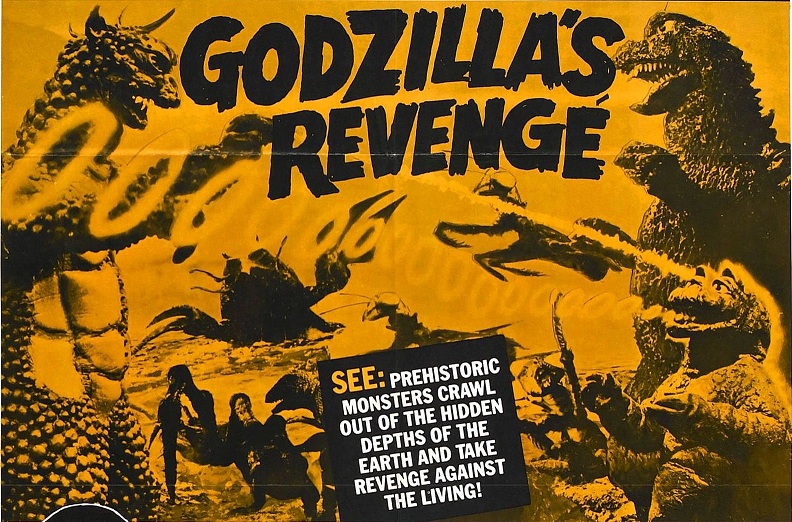
Will children like All Monsters Attack/Godzilla’s Revenge? Yes, they DO. I used to show this movie to kindergarten, first, and second graders as a special treat during story time. And generally they LOVED it. There’s always some squirming during the first scene with Ichiro walking home from school, but they soon settle down and get caught up in the first visit to Monster Island. It’s structured well to be watched in 25 to 30 minute increments (which is what I had to work with).
As an introduction to Godzilla it works very well. It’s child protagonist who is bullied and left on his own resonates with a lot of kids. And despite the fact that it doesn’t compare to today’s SFX laden movies and video games, the kids (even some as old as 9 and 10) get caught up in the story and monsters. You wouldn’t believe how many times I got “Can we watch it again?!”
And if it you want to make it educational, you can have a good discussion about what’s real and what’s imaginary and bullying.
As for the ending and Ichiro’s fighting the bully, all I can say is Honda must have spent a lot of time on school playgrounds. That scene is enacted out in real life every day. For what it’s worth, it doesn’t usually lead to the creation of a new bully, but a sort of a “You stay out of my way; I’ll stay out of yours” kind of thing.
Thanks for going in depth on this movie. I really enjoyed reading your analysis.
I definitely agree with this (and I was bullied like Ichiro at his age because I loved reading and didn’t care for sports, although not at the level Ichiro experiences, thankfully, so I sure feel Ichiro’s desire to strike back hard). It’s the action Ichiro takes afterwards against the painter that really disturbs me, and then makes me reflect on the scene with Gabara with a more critical eye. I’d be fine if Ichiro just struck back at Gabara (and Honda does de-emphasize the violence with an unusual montage of still images, which is an intriguing stylistic choice) and the movie ended there. But what Ichiro does with the painter is not a lesson he learned from Minira. It just… ah, it really spoils the positive feelings I have after the bank robbers’ defeat.
Thanks for sharing the story about showing the film to children. I’m very glad to know that some young kids are enjoying the movie so many years later. If Mr. Honda and his monsters can still reach today’s children, it’s a big win.
[…] and Hallucinogens: All Monsters Attack (1969) and Godzilla vs. Hedorah […]